英语16种时态与被动语态
根据英语的16种时态及其被动语态例句,修改其中的名词:
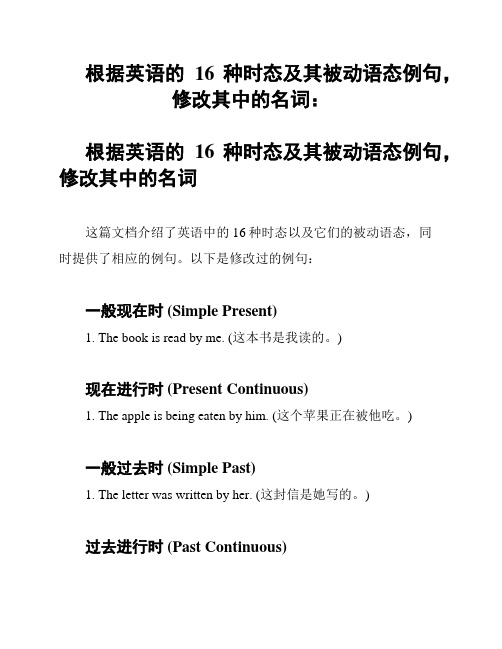
根据英语的16种时态及其被动语态例句,修改其中的名词:根据英语的16种时态及其被动语态例句,修改其中的名词这篇文档介绍了英语中的16种时态以及它们的被动语态,同时提供了相应的例句。
以下是修改过的例句:一般现在时 (Simple Present)1. The book is read by me. (这本书是我读的。
)现在进行时 (Present Continuous)1. The apple is being eaten by him. (这个苹果正在被他吃。
)一般过去时 (Simple Past)1. The letter was written by her. (这封信是她写的。
)过去进行时 (Past Continuous)1. The cake was being baked by them. (这个蛋糕当时正在被他们烤。
)将来一般时 (Simple Future)1. The concert will be attended by us. (这场音乐会将被我们参加。
)将来进行时 (Future Continuous)1. The report will be being written by him. (这份报告将会正在被他写。
)现在完成时 (Present Perfect)1. The movie has been watched by them. (这部电影已经被他们看过。
)过去完成时 (Past Perfect)将来完成时 (Future Perfect)1. The work will have been finished by tomorrow. (这项工作到明天将已经被完成。
)现在完成进行时 (Present Perfect Continuous)1. The book has been being read by her for hours. (这本书她已经读了几个小时了。
16种时态及语态总结
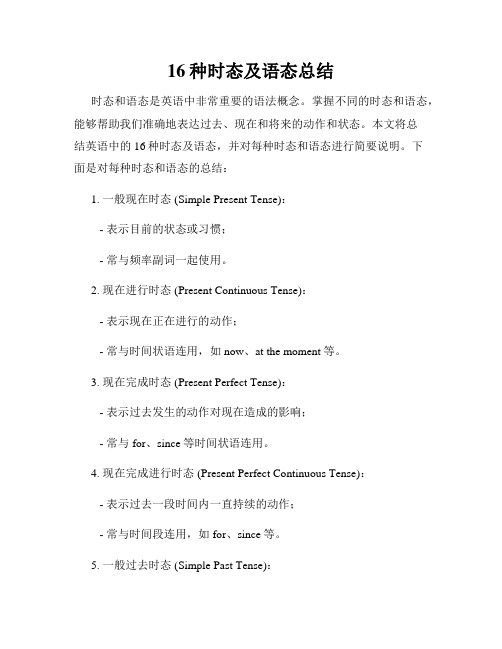
16种时态及语态总结时态和语态是英语中非常重要的语法概念。
掌握不同的时态和语态,能够帮助我们准确地表达过去、现在和将来的动作和状态。
本文将总结英语中的16种时态及语态,并对每种时态和语态进行简要说明。
下面是对每种时态和语态的总结:1. 一般现在时态 (Simple Present Tense):- 表示目前的状态或习惯;- 常与频率副词一起使用。
2. 现在进行时态 (Present Continuous Tense):- 表示现在正在进行的动作;- 常与时间状语连用,如now、at the moment等。
3. 现在完成时态 (Present Perfect Tense):- 表示过去发生的动作对现在造成的影响;- 常与for、since等时间状语连用。
4. 现在完成进行时态 (Present Perfect Continuous Tense):- 表示过去一段时间内一直持续的动作;- 常与时间段连用,如for、since等。
5. 一般过去时态 (Simple Past Tense):- 表示过去发生的动作或状态;- 常与表示具体时间的状语连用。
6. 过去进行时态 (Past Continuous Tense):- 表示过去某个时间段内正在进行的动作;- 常与表示具体时间的状语连用。
7. 过去完成时态 (Past Perfect Tense):- 表示过去某个时间点之前已经发生的动作;- 常与表示具体时间的状语连用。
8. 过去完成进行时态 (Past Perfect Continuous Tense): - 表示过去某个时间点之前一直持续的动作;- 常与表示具体时间的状语连用。
9. 一般将来时态 (Simple Future Tense):- 表示将来要发生的动作或状态;- 常与表示将来时间的状语连用。
10. 将来进行时态 (Future Continuous Tense):- 表示将来某一时刻正在进行的动作;- 常与表示将来时间的状语连用。
16种时态及语态总结计划

16种时态及语态总结计划时态和语态是英语语法中非常重要的部分,掌握好它们对于准确表达意思、理解英语句子至关重要。
下面我们就来详细地总结一下 16 种时态及语态。
一般现在时:表示经常发生的动作或存在的状态。
例如,“I play basketball every weekend”(我每个周末都打篮球。
)其被动语态为“Basketball is played by me every weekend”一般过去时:用于过去某个时间发生的动作或存在的状态。
比如,“He visited his grandparents last month”(他上个月看望了他的祖父母。
)被动语态是“His grandparents were visited by him last month”一般将来时:表示将来要发生的动作或存在的状态。
“I will go to Beijing next week”(我下周将去北京。
)被动形式则为“Beijing will be gone to by me next week”过去将来时:立足于过去某一时间,看将来要发生的动作。
“She said she would com e here the next day” 被动是“She said she would be come here by her the next day”现在进行时:正在进行的动作。
“They are playing football now” 被动为“Football is being played by them now”过去进行时:过去某一时刻正在进行的动作。
“I was reading a book at that time yesterday” 被动为“A book was being rea d by me at that time yesterday”将来进行时:将来某一时刻正在进行的动作。
“This time next week, I will be having a meeting” 被动是“This time next week, a meeting will be being had by me”现在完成时:过去发生的动作对现在造成的影响或结果。
英语16大时态及8种被动语态图表

动词的时态在英语中,由于谓语动作发生的时间不同,或表达不同时间存在的状态,谓语动词都要发生相应的变化.这些动词的形式就叫做动词的时态.英语动词的时态共有16种,列表如下:(以动词write为例)被动语态的构成疑问句时,须将第一个助动词移至主语之前,构成被动语态的否定句时,助动词后须加not. 各个时态的被动形式列表如下:(以动词teach为例)英语被动语态讲解(一)语态的基本概念和种类语态是动词的一种形式,用来表明主语与谓语动词之间的关系。
所以英语的语态是通过动词形式的变化表现出来的。
语态有两种:主动语态和被动语态。
主语是动作的发出者为主动语态;主语是动作的接受者为被动语态。
如:They built the bridge.The bridge was built by them.(二)被动语态的构成被动语态由“助动词be+及物动词的过去分词”构成。
人称、数和时态的变化是通过be的变化表现出来的。
歌诀是:被动语态be字变,过去分词跟后面。
情态动词的被动语态是常考的一个知识点:情态动词+be+过去分词(三)被动语态的用法1)不知道或没有必要说明动作的执行者是谁。
例如:Some new puters were stolen last night.一些新电脑在昨晚被盗了。
(不知道电脑是谁偷的)This book was published in 1981.这本书出版于1981年。
(2)强调动作的承受者,而不强调动作的执行者。
例如:the window was broken by Mike.窗户是迈克打破的。
This book was written by him.这本书是他写的。
Eight hours per day for sleep must be guaranteed.每天8小时睡眠必须得到保证。
(四)主动语态变被动语态的方法与注意事项(1) 通常的办法是:将主动结构中的宾语变为被动结构中的主语,将主动结构中的谓语动词变为“be / get +过去分词”形式,将主动结构中的主语变为介词by的宾语(若动作的执行者没有必要说明则可以省略该by短语)。
英语16种动词时态和语态大全表2.2版

英语动词16种时态(被动语态)以do为例例1⼀一般时2进⾏行行时3完成时4完成进⾏行行时A现在①do被动(am/is/are done)⑤am/is/are doing被动(am/is/are being done)⑦have done被动(have/has been done)have been doing被动[have/has been being done]B过去②did被动(was/were done)⑥was/were doing被动(was/were being done)⑧had done被动(had been done)had been doing被动[had been being done]C将来③will do被动(will be done)will be doing被动[will be being done]will have done被动(will have been done)will have been doing被动[will have been being done]D过去将来④would do被动(would be done)would be doing被动[would be being done]would have done被动[would have been done]would have been doing被动[would have been being done]说明:①括号内为理理论上推出来的被动语态结构, 有些并不不⽤用②be going to do虽有和will do同样意义,但不不归类在⼀一般将来时⾥里里,属于现在进⾏行行时表将来英语动词的5种基本形式[基本]原型V[基本]三单V-s现在分词V-ing过去式V-ed过去分词V-ed中⽂文意思1be(am/is/are)is being was/were been是2become becomes becoming became become成为3begin begins beginning began begun开始4break breaks breaking broke broken打破5close closes closing closed closed关闭6do does doing did done做7drink drinks drinking drank drunk喝喝8drive drives driving drove droven开⻋车9findfindsfinding found found发现10get gets getting got got/gotten得到11go goes going went gone⾛走12have has having had had有13leave leaves leaving left left离开14move moves moving moved moved移动15put puts putting put put放下16say says saying said said说17smile smiles smiling smiled smiled微笑18start starts starting started started开始19swim swims swimming swam swum游泳20take takes taking took taken拿⾛走21work works working worked worked⼯工作英语16种动词时态例例句句(以do为例例)A1(⼀一般)现在present simple①I do my homework everyday.②China is a big country.A2现在进⾏行行present continuous①I am doing my homework now.②She is drinking water now.A3现在完成present perfect①I have done my homework. (I’m done with it. Now I can go out.)②I have waited for you for 2 hours. (Now you are here. Let’s go)A4现在完成进⾏行行present perfect continuous①I have been doing my homework for a long time.(I’m not donewith it. I have to keep doing it for another 2 two hours.)②I have been waiting for you for 2 hours. (You’re still on your way. Ihave to keep waiting for another 2 hours.)B1(⼀一般)过去past simple①I did my homework yesterday.②Japan invaded China in World War II.B2过去进⾏行行past continuous①I was doing my homework this time yesterday.B3过去完成past perfect①I told my mum that I had done my homework. (Then I went outfor a walk with my friend.)B4过去完成进⾏行行past perfect continuous①By the time my mum arrived home, I had been doing myhomework for 2 hours. ( But I wasn’t done. I had to keep doing itfor one more hour.)C1(⼀一般)将来future simple①I will do my homework tomorrow. (I don’t want to do it now.)C2将来进⾏行行future continuous①I will be doing my homework this time tomorrow. (Don’t call meout.)②I will be sleeping at 6:00 am tomorrow, so don’t call me. (I don’twant to be disturbed.)C3将来完成future perfect①I will have done my homework at 3:00 pm. (According to my plan,I can finish it at 3:00 pm this afternoon. So we can go to the parkand relax.)C4将来完成进⾏行行future perfect continuous①I will have been doing my homework for 2 hours by 3:00 pm. (AndI have to spend 1 more hour to finish it. I’ll finish it at 4:00 pm.D1(⼀一般)过去将来future simple in the past①I said I would do my homework after the class. (I promised myteacher)D2过去将来进⾏行行future continuous in the past①I said I would be doing my homework at 10:00 pm. (By that time,I would be doing my homework.)D3过去将来完成future perfect in the past①I promised I would have done my homework before going to bed.(My homework would be done before I went to bed.)D4过去将来完成进⾏行行future perfectcontinuous in the past①I said I would have been doing my homework for 2 hours by10:00 pm.。
英语各时态的主动句和被动句

一般将来时(Simple Future):主动语态:明天我将会见我的朋友。
(I will meet my friend tomorrow.)被动语态:我的朋友将被我明天见到。
(My friend will be met by me tomorrow.)主动语态:下个月我将搬到一个新的城市。
(I will move to a new city next month.)被动语态:一个新的城市将被我下个月搬到。
(A new city will be moved to by me next month.)主动语态:明年我将开始学习弹钢琴。
(I will start learning to play the piano next year.)被动语态:学习弹钢琴将被我明年开始。
(Learning to play the piano will be started by me next year.)现在进行时(Present Continuous):主动语态:我正在看电视节目。
(I am watching a TV show.)被动语态:电视节目正在被我观看。
(A TV show is being watched by me.)主动语态:他们正在制定新的计划。
(They are making new plans.)被动语态:新的计划正在被他们制定。
(New plans are being made by them.)主动语态:我们正在等待朋友的到来。
(We are waiting for our friend's arrival.)被动语态:朋友的到来正在被我们等待。
(Our friend's arrival is being waited for by us.)现在完成时(Present Perfect):主动语态:我已经完成了我的工作报告。
(I have finished my work report.)被动语态:我的工作报告已经被我完成了。
(word完整版)史上最全 英语中的16种时态
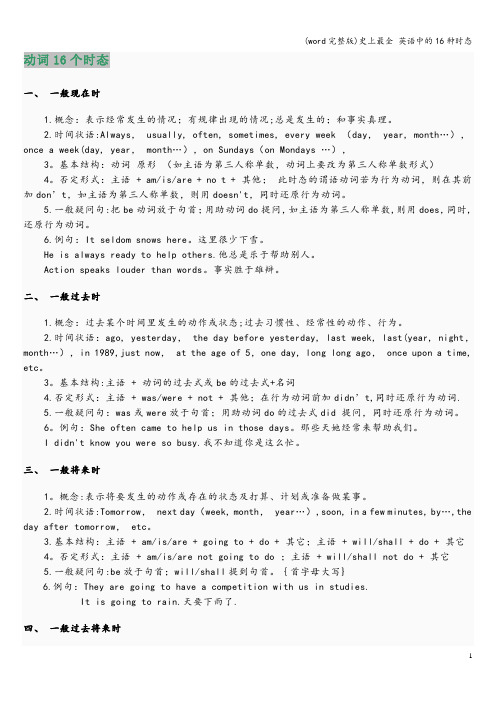
动词16个时态一、一般现在时1.概念:表示经常发生的情况;有规律出现的情况;总是发生的;和事实真理。
2.时间状语:Always, usually, often, sometimes, every week (day,year, month…),once a week(day, year,month…),on Sundays(on Mondays …),3。
基本结构:动词原形(如主语为第三人称单数,动词上要改为第三人称单数形式)4。
否定形式:主语 + am/is/are + no t + 其他;此时态的谓语动词若为行为动词,则在其前加don’t,如主语为第三人称单数,则用doesn't,同时还原行为动词。
5.一般疑问句:把be动词放于句首;用助动词do提问,如主语为第三人称单数,则用does,同时,还原行为动词。
6.例句:It seldom snows here。
这里很少下雪。
He is always ready to help others.他总是乐于帮助别人。
Action speaks louder than words。
事实胜于雄辩。
二、一般过去时1.概念:过去某个时间里发生的动作或状态;过去习惯性、经常性的动作、行为。
2.时间状语:ago, yesterday, the day before yesterday, last week, last(year, night,month…),in 1989,just now, at the age of 5,one day, long long ago, once upon a time, etc。
3。
基本结构:主语 + 动词的过去式或be的过去式+名词4.否定形式:主语 + was/were + not + 其他;在行为动词前加didn’t,同时还原行为动词.5.一般疑问句:was或were放于句首;用助动词do的过去式did 提问,同时还原行为动词。
英语16种时态及被动语态_表格打印版
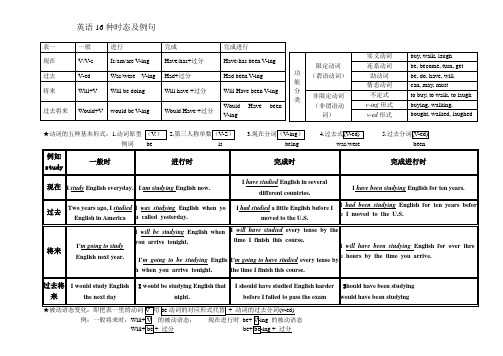
英语16种时态及例句★动词的五种基本形式:1.动词原型 (V .) 2.第三人称单数(V -S ) 3.现在分词(V -ing ) 4.过去式(V -ed) 5.过去分词(V -ed)例词 be is being was/were been例如study一般时 进行时 完成时完成进行时现在 I study English everyday. I am studying English now.I have studied English in severaldifferent countries.I have been studying English for ten years.过去Two years ago, I studied English in America I was studying English when you called yesterday.I had studied a little English before I moved to the U.S. I had been studying English for ten years before I moved to the U.S.将来I’m going to study English next year.I will be studying English when you arrive tonight.I’m going to be studying Englis h when you arrive tonight. I will have studied every tense by the time I finish this course.I’m going to have studied every tense by the time I finish this course.I will have been studying English for over three hours by the time you arrive. 过去将来 I would study English the next dayI would be studying English thatnight.I should have studied English harder before I failed to pass the examS hould have been studying would have been studying★被动语态变化:即把表一里的动词V 用be 动词的对应形式代替 + 动词的过去分词(v-ed) 例:一般将来时:Will+ V 的被动语态: 现在进行时 be+ V-ing 的被动语态 Will+ be + 过分 be+ be-ing + 过分功能分类 限定动词 (谓语动词) 实义动词buy, walk, laugh 连系动词 be, become, turn, get 助动词 be, do, have, will 情态动词 can, may, must非限定动词 (非谓语动词)不定式 to buy, to walk, to laugh v-ing 形式 buying, walking,v-ed 形式bought, walked, laughed表一 一般 进行完成完成进行现在 V/V -s Is/am/are V -ing Have/has+过分 Have/has been V -ing 过去 V -ed Was/were V -ing Had+过分 Had been V -ing 将来 Will+VWill be doingWill have +过分 Will Have been V -ing 过去将来Would+V would be V -ingWould Have +过分Would Have beenV -ing。
英语16种时态与被动语态

英语中的16种时态与被动语态※ 1.一般现在时※基本结构:S + V(原形)被动语态:受动者+ am / is / are + V(过去分词)※ 2.一般过去时※基本结构:S + V(过去式)被动语态:受动者+ was / were + V(过去分词)※ 3.一般将来时※基本结构: S + will / shall / be (am / is / are) going to +V(原形)被动语态:受动者+ will + be + V(过去分词)※ 4.一般过去将来时※基本结构:S + would + V(原形)被动语态:受动者+ would + be + V(过去分词)基本结构:S + am / is / are + V ing被动语态:受动者+ am / is /are + being + V(过去分词)※ 6.过去进行时※基本结构:S + was / were + V ing被动语态:受动者+ was / were + being +V(过去分词)※7.将来进行时※基本结构:S + will + be + V ing被动语态:受动者+ will + being + V(过去分词)※8.过去将来进行时※基本结构:S + would + be + V ing被动语态:受动者+ would + being + V(过去分词)基本结构:S + have / has + V(过去分词)被动语态:受动者+ have / has + been + V(过去分词)※10.过去完成时※基本结构:S + had + V(过去分词)被动语态:受动者+ had + been +V(过去分词)※11.将来完成时※基本结构:S+will+have+V(过去分词)被动语态:受动者+ will + have + been + V(过去分词)※12.过去将来完成时※基本结构:S + would + have + V(过去分词)被动语态:受动者+ would + have + been + V(过去分词)基本结构:S + have / has / + been + V ing被动语态:受动者+ have + has + been + being + V(过去分词)※14.过去完成进行时※基本结构:S + had + been + V ing被动语态:受动者+ had + been + being + V(过去分词)※15.将来完成进行时※基本结构:S + will + have + been + V ing被动语态:受动者+ will + have + been + being + V(过去分词)※16.过去将来完成进行时※基本结构:S + would + have + been + V ing被动语态:受动者+ would+ have+ been +being + V(过去分词)。
16种时态及语态总结计划

16种时态及语态总结计划在英语学习中,时态和语态是非常重要的语法知识点。
掌握好时态和语态,能够让我们更准确、清晰地表达自己的意思。
下面就为大家详细总结一下 16 种时态及语态。
一、一般时态1、一般现在时一般现在时表示经常发生的动作、习惯性的动作或者客观存在的事实。
结构:主语+动词原形(当主语是第三人称单数时,动词要加 s 或 es)例如:I play football every weekend (我每个周末踢足球。
)He likes reading books (他喜欢读书。
)2、一般过去时一般过去时表示过去发生的动作或存在的状态。
结构:主语+动词的过去式例如:I went to Beijing last year (我去年去了北京。
)We had a great time at the party (我们在聚会上玩得很开心。
)3、一般将来时一般将来时表示将来要发生的动作或存在的状态。
结构:主语+ will +动词原形或者主语+ be going to +动词原形例如:I will visit my grandparents next week (我下周要去看望我的祖父母。
)She is going to study abroad next year (她明年要出国留学。
)二、进行时态1、现在进行时现在进行时表示现在正在进行的动作。
结构:主语+ am/is/are +现在分词例如:I am watching TV now (我现在正在看电视。
)They are playing basketball in the playground (他们正在操场上打篮球。
)2、过去进行时过去进行时表示过去某个时刻正在进行的动作。
结构:主语+ was/were +现在分词例如:I was doing my homework at eight o'clock last night (昨晚八点我正在做作业。
各种时态的被动语态

各种时态的被动语态各种时态的被动语态一、八大时态的被动语态的构成:1.一般现在时的被动语态构成:(am/is/are +done)如:I am asked to study hard. 我被请求努力学习。
This shirt is washed once a week. 这件T恤一周洗一次。
These songs are usually sung by boys. 这些歌曲通常是男生唱的。
2.一般过去时的被动语态构成:(was/were done)如:The soldier was killed, but the train was saved. 这位战士牺牲了,然而列车得救了。
Some notes were passed up to the speaker. 有人给讲演者递上来一些纸条。
3.一般将来时的被动语态构成:(shall/will be done)如:We shall be asked a lot of strange questions. 我们将被问许多怪题。
My son will be sent to school next September. 来年九月我将送我儿子去读书。
4.过去将来时的被动语态构成:(should/would be done)如:The news would be sent to him as soon as it arrived. 消息一到就会转给他的。
He told us that the new railway would be built the next year. 他告诉我新铁路将在明年修建。
5.现在完成时的被动语态构成:(has/have been done)如:The work has just been finished. 工作刚刚结束。
The old rules have been done away with by us. 旧规章已经被我们废除了。
高中英语中的16种时态详细讲解
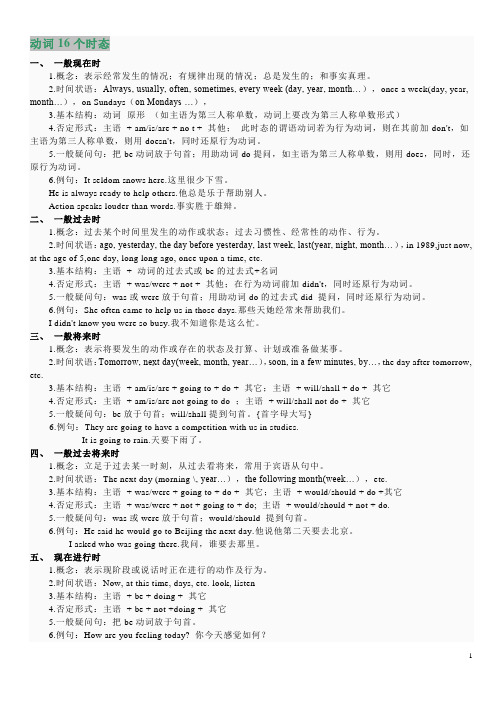
动词16个时态一、一般现在时1.概念:表示经常发生的情况;有规律出现的情况;总是发生的;和事实真理。
2.时间状语:Always, usually, often, sometimes, every week (day, year, month…),once a week(day, year, month…),on Sundays(on Mondays …),3.基本结构:动词原形(如主语为第三人称单数,动词上要改为第三人称单数形式)4.否定形式:主语+ am/is/are + no t + 其他;此时态的谓语动词若为行为动词,则在其前加don't,如主语为第三人称单数,则用doesn't,同时还原行为动词。
5.一般疑问句:把be动词放于句首;用助动词do提问,如主语为第三人称单数,则用does,同时,还原行为动词。
6.例句:It seldom snows here.这里很少下雪。
He is always ready to help others.他总是乐于帮助别人。
Action speaks louder than words.事实胜于雄辩。
二、一般过去时1.概念:过去某个时间里发生的动作或状态;过去习惯性、经常性的动作、行为。
2.时间状语:ago, yesterday, the day before yesterday, last week, last(year, night, month…),in 1989,just now, at the age of 5,one day, long long ago, once upon a time, etc.3.基本结构:主语+ 动词的过去式或be的过去式+名词4.否定形式:主语+ was/were + not + 其他;在行为动词前加didn't,同时还原行为动词。
5.一般疑问句:was或were放于句首;用助动词do的过去式did 提问,同时还原行为动词。
(完整)英语的16种时态及其被动语态例句

英语的16种时态及其被动语态例句英语的16种时态,及其动语态(be + V过去分词).第一句是主动语态,第二三句是被动。
1 一般现在时用动词原形I often watch TV。
TV is often watched by me。
2 一般过去时用动词过去时I watched TV just now。
TV was watched by me just now.3 现在进行时 be + vingI am watching TV.TV is being watched by me.4 过去进行时 was/were + vingI was watching TV when you came in.TV was being watched by me when you came in。
(注意点跟第3句相同)be going to + 动词原形 5 一般将来时 will + 动词原形或I will go to the zoo on Sunday。
The zoo will be visited by me on Sunday.(注意这里will可以用is going to代替)6 过去将来时 would + 动词原形或 was/were going to + 动词原形Yesterday he told me he would go to the zoo next Sunday。
Yesterday he told me the zoo would be visited by him next Sunday。
(单被动)Yesterday I was told by him the zoo would be visited by him next Sunday. (双被动) (注意,这里的would可以用 was going to 代替)7 现在完成时 have/has + v过去分词I have finished my homework。
英语的16种时态、被动语态和例句分类总结

英语的16种时态,及其被动语态(be + V过去分词)。
1.一般现在时用原形V 或 V+esI often watch TV.我经常看电视。
TV is often watched by me.电视经常被我观看。
2.一般过去时用动词过去时I watched TV just now.我刚才还在看电视。
TV was watched by me just now.电视刚才被我看。
3. 一般将来时 will + 动词原形或be going to + 动词原形I will visit the zoo on Sunday.我星期天要去动物园。
The zoo will be visited by me on Sunday.这个动物园在星期天要被我参观。
(注意这里will可以用is going to代替)4. 过去将来时 would + 动词原形或 was/were going to + 动词原形Yesterday he told me he would visit the zoo next Sunday.昨天他告诉我他下个星期天要去动物园。
Yesterday he told me the zoo would be visited by him next Sunday. (单被动)Yesterday I was told by him the zoo would be visited by him next Sunday. (双被动) (注意,这里would 可以用 was going to 代替)5. 现在进行时 be + vingI am watching TV.我正在看电视。
TV is being watched by me.电视正在被我看。
6. 过去进行时 was/were + vingI was watching TV when you came in.当你进来的时候,我正在看电视。
TV was being watched by me when you came in. 当你进来的时候,电视正在被我看。
英语16大时态和8种被动语态
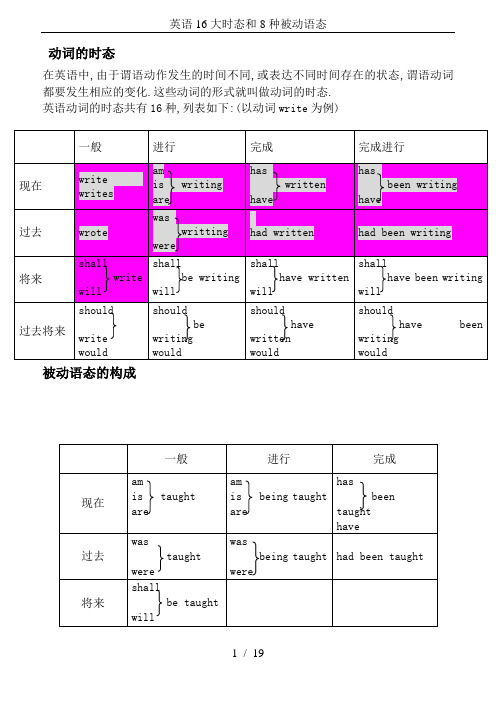
动词的时态在英语中,由于谓语动作发生的时间不同,或表达不同时间存在的状态,谓语动词都要发生相应的变化.这些动词的形式就叫做动词的时态.英语动词的时态共有16种,列表如下:(以动词write 为例)被动语态的构成一般 进行 完成 完成进行 现在 write writes am is writing arehas writtenhave has been writing have 过去wrote waswrittingwere had written had been writing 将来 shall write will shall be writing will shall have written will shall have been writingwill过去将来 should write wouldshouldbewritingwould should have written would should have been writing would 一般进行 完成 现在amis taughtare am is being taught are has been taught have 过去was taught were was being taught were had been taught 将来 shall be taught will被动语态由助动词be 加过去分词构成,时态通过be 表现出来.构成被动语态的一般疑问句时,须将第一个助动词移至主语之前,构成被动语态的否定句时,助动词后须加not. 各个时态的被动形式列表如下:(以动词teach 为例)英语被动语态讲解(一)语态的基本概念和种类语态是动词的一种形式,用来表明主语与谓语动词之间的关系。
所以英语的语态是通过动词形式的变化表现出来的。
语态有两种:主动语态和被动语态。
主语是动作的发出者为主动语态;主语是动作的接受者为被动语态。
英语中的16种时态(全)

动词16个时态一、一般现在时1.概念:表示经常发生的情况;有规律出现的情况;总是发生的;和事实真理。
2.时间状语:Always, usually, often, sometimes, every week (day, year, month…),once a week(day, year, month…),on Sundays(on Mondays …),3.基本结构:动词原形(如主语为第三人称单数,动词上要改为第三人称单数形式)4.否定形式:主语 + am/is/are + no t + 其他;此时态的谓语动词若为行为动词,则在其前加don't,如主语为第三人称单数,则用doesn't,同时还原行为动词。
5.一般疑问句:把be动词放于句首;用助动词do提问,如主语为第三人称单数,则用does,同时,还原行为动词。
6.例句:It seldom snows here.这里很少下雪。
He is always ready to help others.他总是乐于帮助别人。
Action speaks louder than words.事实胜于雄辩。
二、一般过去时1.概念:过去某个时间里发生的动作或状态;过去习惯性、经常性的动作、行为。
2.时间状语:ago, yesterday, the day before yesterday, last week, last(year, night, month…),in 1989,just now, at the age of 5,one day, long long ago, once upon a time, etc.3.基本结构:主语 + 动词的过去式或be的过去式+名词4.否定形式:主语 + was/were + not + 其他;在行为动词前加didn't,同时还原行为动词。
5.一般疑问句:was或were放于句首;用助动词do的过去式did 提问,同时还原行为动词。
英语时态及句型+主动被动
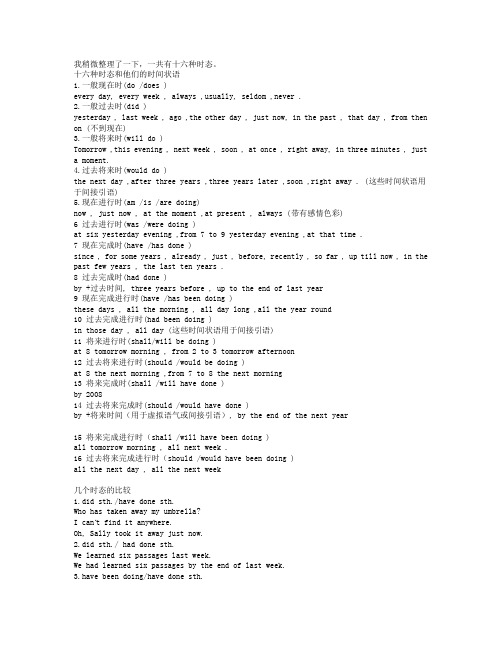
我稍微整理了一下,一共有十六种时态。
十六种时态和他们的时间状语1.一般现在时(do /does )every day, every week , always ,usually, seldom ,never .2.一般过去时(did )yesterday , last week , ago ,the other day , just now, in the past , that day , from then on (不到现在)3.一般将来时(will do )Tomorrow ,this evening , next week , soon , at once , right away, in three minutes , justa moment.4.过去将来时(would do )the next day ,after three years ,three years later ,soon ,right away . (这些时间状语用于间接引语)5.现在进行时(am /is /are doing)now , just now , at the moment ,at present , always (带有感情色彩)6 过去进行时(was /were doing )at six yesterday evening ,from 7 to 9 yesterday evening ,at that time .7 现在完成时(have /has done )since , for some years , already , just , before, recently , so far , up till now , in t he past few years , the last ten years .8 过去完成时(had done )by +过去时间, three years before , up to the end of last year9 现在完成进行时(have /has been doing )these days , all the morning , all day long ,all the year round10 过去完成进行时(had been doing )in those day , all day (这些时间状语用于间接引语)11 将来进行时(shall/will be doing )at 8 tomorrow morning , from 2 to 3 tomorrow afternoon12 过去将来进行时(should /would be doing )at 8 the next morning ,from 7 to 8 the next morning13 将来完成时(shall /will have done )by 200814 过去将来完成时(should /would have done )by +将来时间(用于虚拟语气或间接引语), by the end of the next year15 将来完成进行时(shall /will have been doing )all tomorrow morning , all next week .16 过去将来完成进行时(should /would have been doing )all the next day , all the next week几个时态的比较1.did sth./have done sth.Who has taken away my umbrella?I can’t find it anywhere.Oh, Sally took it away just now.2.did sth./ had done sth.We learned six passages last week.We had learned six passages by the end of last week.3.have been doing/have done sth.They have repaired several cars.They have been repairing cars.语态:分为主动和被动。
- 1、下载文档前请自行甄别文档内容的完整性,平台不提供额外的编辑、内容补充、找答案等附加服务。
- 2、"仅部分预览"的文档,不可在线预览部分如存在完整性等问题,可反馈申请退款(可完整预览的文档不适用该条件!)。
- 3、如文档侵犯您的权益,请联系客服反馈,我们会尽快为您处理(人工客服工作时间:9:00-18:30)。
英语中的16种时态与被动语态
※ 1.一般现在时※
基本结构:S + V(原形)
被动语态:受动者+ am / is / are + V(过去分词)
※ 2.一般过去时※基本结构:S + V(过去式)
被动语态:受动者+ was / were + V(过去分词)
※ 3.一般将来时※基本结构: S + will / shall / be (am / is / are) going to +V(原形)
被动语态:受动者+ will + be + V(过去分词)
※ 4.一般过去将来时※基本结构:S + would + V(原形)
被动语态:受动者+ would + be + V(过去分词)
基本结构:S + am / is / are + V ing
被动语态:受动者+ am / is /are + being + V(过去分词)
※ 6.过去进行时※基本结构:S + was / were + V ing
被动语态:受动者+ was / were + being +V(过去分词)
※7.将来进行时※基本结构:S + will + be + V ing
被动语态:受动者+ will + being + V(过去分词)
※8.过去将来进行时※基本结构:S + would + be + V ing
被动语态:受动者+ would + being + V(过去分词)
基本结构:S + have / has + V(过去分词)
被动语态:受动者+ have / has + been + V(过去分词)
※10.过去完成时※基本结构:S + had + V(过去分词)
被动语态:受动者+ had + been +V(过去分词)
※11.将来完成时※基本结构:S+will+have+V(过去分词)
被动语态:受动者+ will + have + been + V(过去分词)
※12.过去将来完成时※基本结构:S + would + have + V(过去分词)
被动语态:受动者+ would + have + been + V(过去分词)
基本结构:S + have / has / + been + V ing
被动语态:受动者+ have + has + been + being + V(过去分词)
※14.过去完成进行时※基本结构:S + had + been + V ing
被动语态:受动者+ had + been + being + V(过去分词)
※15.将来完成进行时※基本结构:S + will + have + been + V ing
被动语态:受动者+ will + have + been + being + V(过去分词)
※16.过去将来完成进行时※基本结构:S + would + have + been + V ing
被动语态:受动者+ would+ have+ been +being + V(过去分词)。
